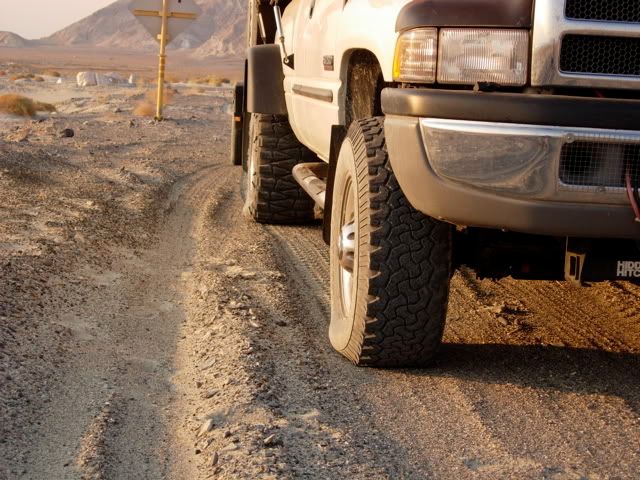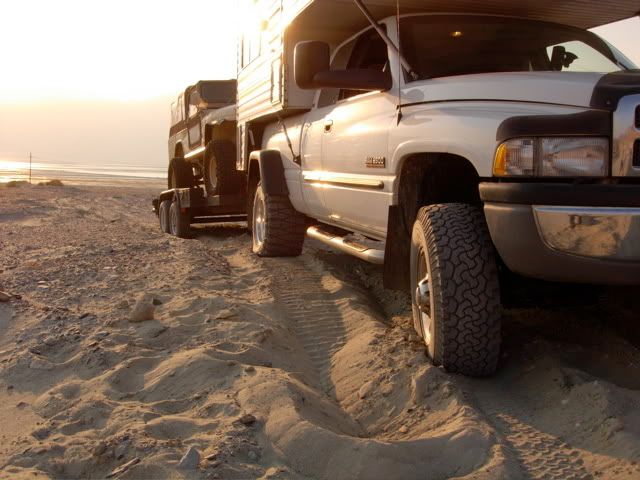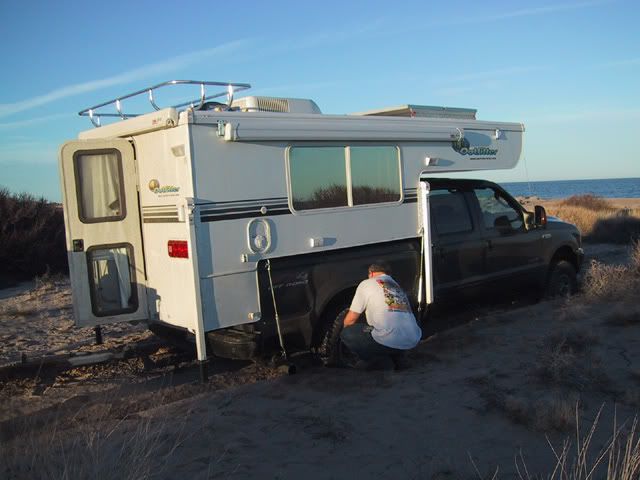Like Skipbee, we've done a lot of over sand driving, in 4x4's from lightweight to heavyweight. You first must know your sand. Before venturing out to the bottomless terrain, watch what others are doing to see how they get to floatation. On your first trip on sand be sure you have another, same weight rig to bail you out, if necessary. Back 50 years, my tire man, the late Dick Cepek was on hand to teach me the ropes with Jeeps and Land Cruisers. He coined the term Hi-floatation, and had an 11-15 farm implement tire called, the Hi-Flot. When aired down to about 8 pounds for sand, they were just great. So the next thing to know is how much sidewall and tread you need to 'float' the weight of your rig. When my 4x4's started getting heavier, I did not have to air down the tires as far; with my FJ-55 with lots of add-ons (about 4400 pound) I could air down only to 10 or 11 pounds to get the right balance between sidewall flex/tread lengthening/floatation. Later on my CJ-8 Scrambler (heavy everything including armor plated ends and steel rails under the doors) with 37x13.50, stiff treaded tires I would go down to 4-5 pounds for sand. After buying a brand new 2001 Dodge 2500 i refrained from driving in sand.....for a while. The stock Michelin tires were too narrow for low pressure sand driving. Then in short fit of upgrading, purchased 12" wide 16" wheels for the rear axle. The super single tire I picked was a 33x14.50R16 Mud tire which put out an awful noise on the highway but worked just great in loose traction situations involving floatation. my front @ 22 pounds and rr @ 20 pounds:


Unfortunately(?), these also wore like iron and i could not wait to take them off and get my hearing back. The replacements were M.T. 375x55R16 AT tires (33x15.50R16) with a 3750 pound E rating that are at the end of their life expectancy as I speak from a campground in Newport, OR.
For my situation: 10,300 pound TC/stock 8" front wheels with 305x75R16's/the above rear tire and wheel combo, on SOFT, DRY, loose blow sand, mostly on the flat, my choice is 24 pounds-front; and 22 pounds rear. This gives me the best floatation but allows me to go long distances (like the beaches in Baja) albeit slowly, without damaging the tires. You just want to avoid heating up the tires.
Let's talk about rims/wheels. You want a rather wide 16, 17,18 inch wheel with enough sidewall to deflate, and to be able to navigate in sand. Why? Safety beads. There is a little hump all the way around the rim which helps keep the tire bead at the edge of the wheel. What about .5 wheels? No safety bead. The wheel is just a tapered edge, like a flower vase, where the bead is held on by tire pressure alone. Three reasons why .5 wheels/tires are in the not recommended sand class.
1. tapered rim with no safety bead
2. narrow sidewall that will fall off the rim if deflated more than 15 pounds.
3. approaching zero floatation especially @ 80 pounds psi.
This does not, of course take away from their great performance on heavy vehicles on pavement. I never have understood why HumVee's are equipped with .5 wheels. They compensate for the down sides of deflating .5 tires by equipping all of them with bead locks; a kind of bead clamp,or wire cage inside the tire that keeps the bead on the wheel even if running flat. It's just a long and expensive way to go to make .5 wheels sand worthy. In the 100's of 1000's of miles I've driven 4WD's in sand, only once did I experience a bead-sep with beaded wheels. We were going up a steep rocky wash and each and every jeep (small j) rolled over the same, perfect storm rock, and each one had their RF wheel, inside bead lost.
So, in short, take someone along with the same weight rig who has some experience and be sure you have your air-up rig with you. After you've done it a few times, you will say, "my, this is a good time."
jefe


